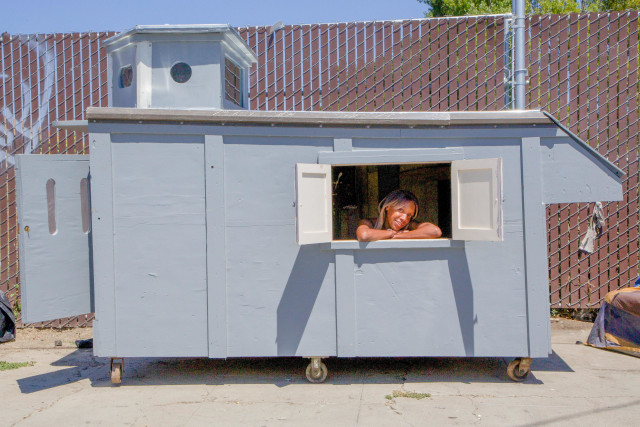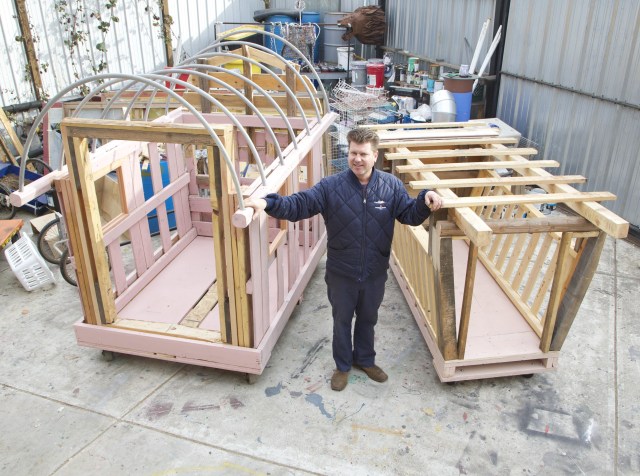Advocates tackling the nation's homeless problem are thinking small.
In Austin, Texas, a village of 200 tiny houses is being built for the homeless. In upstate New York, Rochester Greenovation has designed a prototype for small-scale individualized shelters. “Homeless No More Survival Pods” have been built in Utah, micro-pods in Florida, miniature homes in Wisconsin and mini mobile houses in California.
The “Tiny House Movement,”
once an architectural component to a downsized life, is now becoming
something much bigger: an escape from chronic homelessness.
“This
is a plan that could revolutionize the housing movement in the United
States,” declares Alan Graham, 58, a Texas activist who says his
self-founded organization, Community First, has already lifted 100 homeless people off the streets.
“The city of Austin loves us,” he says. “They think we’re on the verge of breaking the code.”

Brian J Reynolds
Occupy Madison, an offshoot
of the Occupy Wall Street movement based in Madison, Wis., finished
building its first fully functional tiny house last month. The
98-square-foot structure, complete with a bed, toilet and tiny kitchen,
will serve as a template for 40 homes to follow, says Brenda Konkel, an
Occupy Madison board member. It is hoped that the project, which depends
on volunteer labor and community donations, eventually will end
homelessness in their city.
“I
think this is a solution for now,” says Konkel. “Our first house cost
$5,000 to make, and we did it without asking for government help.”
But California artist Gregory Kloen,
43, says there’s an even cheaper and faster way. For the past several
years, Kloen has singlehandedly built small, portable homes using
salvaged materials he finds on the street. His cost? Less than $100
each.
“Stuff people just throw
away on the street can give someone a viable home,” says Kloen, whose
environmentally friendly structures are made of everything from wooden
pallets to refrigerator parts. Kloen’s unique, whimsical designs are
both artistic (“I make them cute and funny”) and practical (“I want them
to work well, be strong and watertight.”)
“Now, I can roll my house down the street. Now the police don’t give me a hard time. I keep my house clean and I have no problems.”
Most
importantly, each Kloen design is a thoughtful response to the problems
faced daily by the homeless people in his community. For example,
Oakland’s public safety laws require municipal workers to periodically
sweep up and destroy the belongings of people living on the streets,
something Kloen hopes to circumvent with his mobile home designs.
“I
was sleeping outside on the freeway for two or three years,” recalls
Oakland resident Cathryn Estelle Copeland, 39. “I was using cardboard
for a cover. The police come there sometimes. If you don’t move fast
enough they just take your stuff away.”
Copeland says having a tiny house changed her life.
“Now,
I can roll my house down the street. Now the police don’t give me a
hard time. I keep my house clean and I have no problems.”
Breaking the cycle
While
billions of taxpayer dollars are allocated each year to support
shelters and social service initiatives, homelessness remains a
persistent problem in the U.S. In 2013, an estimated 610,000 people
slept without shelter every night, according to a report by the U.S. Department of Housing and Urban Development.
Advocates
contend that not enough effort is made to break the cycle of
homelessness, while too much money is spent on punishing behavior
related to it. A 2011 report published by the National Law Center on Homelessness and Poverty
says local governments routinely criminalize activities that go
hand-in-hand with living on the street, such as sleeping in public
spaces and loitering. Incarceration costs taxpayers $34,480 per inmate per year, according to the National Alliance to End Homelessness.
“Homeless people spend excessive time in jail or prison, often for petty offenses such as loitering,” stated a 2011 Utah government report.
“The penal system frequently serves as emergency shelter for the
chronically homeless, at far greater cost than other more appropriate
options.”

Brian J Reynolds
An inexpensive structure
like a micro-pod – with insulation, a small bed and a place to store
belongings – is a good, temporary solution to keep a person warm, safe
and out of jail, says Kloen.
“Does it have merit as a
solution to homelessness? As far as giving people a shelter, yeah,
definitely. Is it a solution to homelessness? It’s an answer. An
attempt.”
Historically, measures
that offer temporary respite from homelessness have often failed,
because the problems that cause it – poverty, addiction, mental and/or
physical illness – are often chronic. But recent evidence shows that
access to social services combined with the safety and security of a
permanent home can be effective in breaking the cycle of chronic homelessness.
For instance, Utah’s “Housing First”
program, which gives free, permanent “no strings attached” apartments
to the chronically homeless, claims to be on track to eradicate the
problem. The 8-year pilot program, which costs $11,000 per apartment
annually, has a reported 74 percent success rate.
While
some people believe individual micro-houses could provide the same
benefit, others say turning the fantasy into a reality isn’t easy.
“There were concerns about safety and property values and noise and trash. I reminded them that these people were already living in our community.”
“Our city government [thought] the homes might be a magnet to crime, or make the city look bad,” admits Jay Rowe,
executive director of Rochester Greenovation in upstate New York. Rowe
says the organization’s project, Tiny Homes for the Homeless, was
stalled by red tape and “a whole bunch of maybes.”
But Tiny Home proponents say they won’t give up.
“There were concerns
about safety and property values and noise and trash,” recalls Occupy
Madison’s Konkel. “I reminded them that these people were already living
in our community.”
Estimating
that 100-400 people sleep on the streets of Madison nightly, Konkel
describes her police force as “very understanding and appreciative” of
the Tiny Homes project. She hopes that having the comfort and protection
of a real house will help Madison’s homeless rebuild their lives.
“Where
there’s stability and a home base, safety and normalcy, the mental
health issues some people have are alleviated,” she says. “It’s not
cured but it’s easier to manage.”
Graham
agrees. He says his Community First village is all about healing people
who have experienced profound rejection from society, by welcoming them
back into the community.
“People
think if you build a bunch of houses you’ve ‘solved’ homelessness,” he
says. “I don’t buy into the word ‘solution.’ It’s less an issue of
‘curative’ than ‘palliative.’ By virtue of relieving their suffering, we
hope to make a positive impact. These are God’s beautiful, broken
children.”

No hay comentarios:
Publicar un comentario